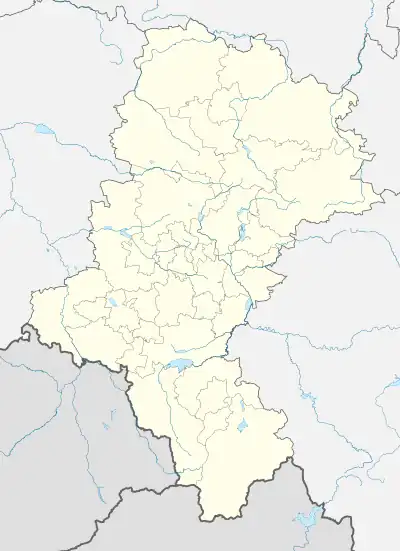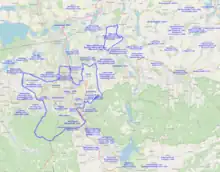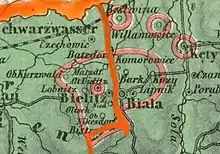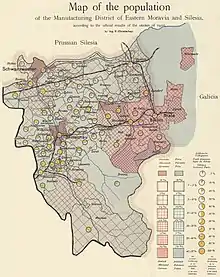Wymysorys language
Wymysorys (Wymysiöeryś, pronounced [vɨmɨˈsʲøːrɪɕ, vɨmɨˈɕœ̯ɛrɪɕ]),[2][3] also known as Vilamovian or Wilamowicean, is a West Germanic language spoken by the Vilamovian ethnic minority in the small town of Wilamowice, Poland (Wymysoü in Wymysorys), on the border between Silesia and Lesser Poland, near Bielsko-Biała.[4][5] It is considered an endangered language,[4] possibly the most so of any of the Germanic languages.[6] There are probably fewer than 20[1] native users of Wymysorys, virtually all bilingual; the majority are elderly.[4]
| Wymysorys | |
|---|---|
| Vilamovian | |
| Wymysiöeryś | |
| Pronunciation | IPA: [vɨmɨˈsʲøːrɪɕ] |
| Native to | Poland |
| Region | Wilamowice, Silesian Voivodeship, Poland |
| Ethnicity | Vilamovians |
Native speakers | 20 (2017)[1] |
Indo-European
| |
| Latin | |
| Language codes | |
| ISO 639-3 | wym |
| Glottolog | wymy1235 |
 Wymysorys  Wymysorys | |
| Coordinates: 49.92°N 19.15°E | |
The status of Wymysorys is complex because, genealogically, it belongs to the East Central dialect group of High German. Nevertheless, based on the self-identification of users as a group separate from the Germans and the existence of a literary language (or, more precisely, a microlanguage), it can be considered a separate language.
It belongs to the dialect group of the former Bielsko-Biała language island, which includes the Alzenau dialect.
History

In origin, Wymysorys is traced to derive from 12th-century Middle High German, with a strong influence from Polish, and presumably also some influence from Low German, Dutch, Old English and perhaps Frisian.[4][7][8] The inhabitants of Wilamowice are thought to be descendants of German, Flemish and Scottish settlers who arrived in Poland during the 13th century.[9] Many of the inhabitants claim that they are descended from the people of Flanders, Friesland, and Holland, with others claiming to be descended from the Anglo-Saxons.[6] Although historically derived from the German dialect continuum, Wymysorys is not mutually intelligible with Standard German.[10]: 15 Unlike in other West Germanic enclave communities in Polish-speaking territory, where closely related dialects (e.g. Halcnovian) were spoken, Wymysorys speakers did not self-identify as Germans and used Polish, not German, as Dachsprache.[11]: 12

Wymysorys was the vernacular language of Wilamowice until World War II. However, it seems it has been in decline since the late 19th century. In 1880 as many as 92% of the town's inhabitants spoke Wymysorys (1,525 out of 1,662 people), in 1890 – only 72%, in 1900 – 67%, in 1910 – 73% again.[10]: 10 Although Wymysorys was taught in local schools (under the name of "local variety of German"), since 1875 the basic language of instruction in most schools in Austro-Hungarian Galicia was Polish.[10]: 10 During World War II and the German occupation of Poland Wymysorys was openly promoted by the Nazi administration, but after the war the tables turned: local communist authorities forbade the use of Wymysorys in any form.[10]: 10 [12] The widespread bilingualism of the people saved most local residents from being forcibly resettled to Germany, many of them stopped teaching their children their language or even using it in daily life.[10]: 12 Although the ban was lifted after 1956, Wymysorys has been gradually replaced by Polish, especially amongst the younger generation. Most of the inhabitants have the same surnames (Mozler, Rozner, Figwer, Biba, Foks, Sznajder), which led to the use of nicknames (Fliöer-Fliöer, Hȧla-Mockja, i.e. Florian, son of Florian or Maciej, son of Elżbieta).
Nowadays, as part of saving the Wymysorys culture, new songs and lyrics are written in this language. The play Hobbit. Hejn ȧn cyryk was written in Wymysorys, based on the prose of J. R. R. Tolkien, which was staged, among others, at the Polish Theatre in Warsaw in February 2016.[13]

Acting on a proposal by Tymoteusz Król, the Library of Congress added the Wymysorys language to the register of languages on 18 July 2007.[14] It was also registered in the International Organization for Standardization, where it received the wym ISO 639-3 code.[5][15] In a 2009 UNESCO report Wymysorys has been reported as "severely endangered" and nearly extinct.[14]
Members of the Wikimedia Polska association were also involved in saving this dying language. As part of the "Wilamowice" project,[16] Wymysorys words read by Józef Gara were recorded, and the Wymysorys dictionary in Wiktionary was supplemented (in 2018, the dictionary consisted of over 7,000 words).[17][18]
Revitalisation



Some new revitalisation efforts were started in the first decade of the 21st century, led by speaker Tymoteusz Król, whose efforts include private lessons with a group of pupils as well as compiling language records, standardising written orthography and compiling the first ever dictionary of Wymysorys. Additionally, a new project called The Wymysiöeryśy Akademyj – Accademia Wilamowicziana or WA-AW was established under the "Artes Liberales" program at the University of Warsaw with the intention of creating a unified scholastic body for the study of the Wymysorys language.[19]
Phonology
Consonants
- Voiced stops, sibilant fricatives and affricates are regularly devoiced or voiceless in final position.
- The sounds of /x/ and /h/ are interchangeable among different speakers. The use of [x] is typically heard at the beginning of a word, possibly due to the influence of Polish, even though historically in Germanic languages, the glottal fricative [h] is typically heard.
- The series of palato-alveolar /ʃ, ʒ, t͡ʃ/ and alveolo-palatal /ɕ, ʑ, t͡ɕ/ fricative and affricate sounds, are heard interchangeably among various speakers.
- [ç] is heard in word-final position, as an allophone of /x/.
- The voiced affricates /d͡z, d̠͡z̠, d͡ʒ, d͡ʑ/ are only heard in Polish loanwords.
- A series of flat post-alveolar sibilants and affricates [s̠, z̠, t̠͡s̠, d̠͡z̠], are also heard in Polish loanwords, interchangeably with alveolar-palatal sounds /ɕ, ʑ, t͡ɕ, d͡ʑ/.
- The labial-velar approximant /w/ is pronounced with a lesser degree of lip rounding than in English, and is more similar to the Polish pronunciation of ł [w].[6]
Vowels
| Front | Central | Back | |||
|---|---|---|---|---|---|
| Close | i | y | (ɨ) | (ʉ) | u |
| Near-close | ɪ | ʏ | |||
| Close-mid | e | ø | ɘ | o | |
| Mid | ə | ||||
| Open-mid | ɛ | œ | ɔ | ||
| Open | a | ɑ | |||
- The close-mid sound /ɘ/ is phonetically more fronted as [ɘ̟].
- Mid central vowel sounds /ɘ, ə/ are also heard close central sounds [ɨ, ʉ], among speakers.[6]
| Front | Front | Back | |
|---|---|---|---|
| ascending | descending | ||
| Close | i̯ø | ||
| Close-mid | ɪ̯ɘ̟ | ei̯ | |
| Open-mid | œʏ̯ | ɔi̯ | |
| Open | ai̯ | ||
| Triphthong | ʏ̯øœ̯ | ||
Alphabet
Wymysorys has been for centuries mostly a spoken language. It was not until the times of Florian Biesik, the first author of major literary works in the language, that a need for a separate version of a Latin alphabet arose. Biesik wrote most of his works in plain Polish alphabet, which he considered better-suited for the phonetics of his language.[10]: 24 In recent times Józef Gara (1929–2013), another author of works in the local language, devised a distinct Wymysorys alphabet, consisting of 34 letters derived from the Latin script and mostly based on Polish as well:
| Majuscule forms (also called uppercase or capital letters) | |||||||||||||||||||||||||||||||||
|---|---|---|---|---|---|---|---|---|---|---|---|---|---|---|---|---|---|---|---|---|---|---|---|---|---|---|---|---|---|---|---|---|---|
| A | AO | B | C | Ć | D | E | F | G | H | I | J | K | Ł | L | M | N | Ń | O | Ö | P | R | S | Ś | T | U | Ü | W | X[20] | Y | Z | Ź | Ż | |
| Minuscule forms (also called lowercase or small letters) | |||||||||||||||||||||||||||||||||
| a | ao | b | c | ć | d | e | f | g | h | i | j | k | ł | l | m | n | ń | o | ö | p | r | s | ś | t | u | ü | w | x[20] | y | z | ź | ż | |
Wymysorys orthography includes the digraph "AO", which is treated as a separate letter.
Example words and their relationship to other languages
A sample of Wymysorys words with German, Dutch and English translations. Note that ł is read in Wymysorys like English w (as in Polish), and w like v (as in Polish and German):
| English | Wymysorys | Middle High German | Standard High German | Dutch | Frisian | Comment |
|---|---|---|---|---|---|---|
| alone | ałan | alein(e) | allein | alleen | allinne | |
| and | ana, an | und(e), unt | und | en | en | |
| bridge | bryk | brücke, brucke | Brücke | brug | brêge | |
| dolt | duł | tol, dol 'foolish, nonsensical' | toll 'mad, fantastic, wonderful' | dol 'crazy' | dol 'furious' | |
| hear | fulgia | volgen | hören | horen | folgje | < Frisian; cf. WFris. folgje, EFris foulgje 'to follow'. cf. German folgen, Dutch volgen 'to follow' |
| wholly | ganc | ganz | ganz | gans | gâns | |
| court | gyrycht | geriht | Gericht | gerecht | rjocht | cf. German Recht, Dutch recht '(legal) right', English right) |
| dog | hund | hunt | Hund | hond | hûn | cf. English hound |
| heaven | hymuł | himel | Himmel | hemel | himel | |
| love | łiwa | liebe | Liebe | liefde | leafde | |
| a bit | a mikieła | michel 'much' | ein bisschen | een beetje | in bytsje | Scots mickle, English much; antonymic switch 'much' → 'little' |
| mother | müter | muoter | Mutter | moeder | mem | |
| middle | mytuł | mittel | Mitte | middel | midden/mid | |
| no one | nimanda | nieman | niemand | niemand | nimmen | |
| no | ny | ne, ni | nein | nee(n) | nee | |
| picture | obrozła | -- | Bild | beeld | byld | < Slavic; cf. Polish obraz |
| breath | ödum | Middle German ādem | Atem | adem | azem | cf. archaic/poetic German Odem, Central Franconian Öödem |
| elephant | olifant | elefant | Elefant | olifant | oaljefant | < Dutch |
| evening | öwyt | ābent | Abend | avond | jûn | |
| welcome | sgiöekumt | wil(le)kōme(n) | wilkommen | welkom | wolkom | |
| write | śrajwa | schrīben | schreiben | schrijven | skriuwe | |
| stone | śtaen | stein | Stein | steen | stien | |
| sister | syster | swester | Schwester | zuster | suster | |
| drink | trynkia | trinken | trinken | drinken | drinke | |
| world | wełt | werlt | Welt | wereld | wrâld | |
| winter | wynter | winter | Winter | winter | winter | |
| seven | zyjwa | Middle German siven | sieben | zeven | sân | |
| silver | zyłwer | silber | Silber | zilver | sulver |
Sample texts
Lord's Prayer in Wymysorys
|
Ynzer Foter[21] |
Our Father; English translation
|
A lullaby in Wymysorys with English translation:
|
Śłöf maj buwła fest! |
Sleep, my boy, soundly!
|
See also
References
- Wicherkiewicz, Tomasz; Król, Tymoteusz; Olko, Justyna [in Polish] (10 November 2017). "Awakening the Language and Speakers' Community of Wymysiöeryś". European Review. 26 (1): 179–191. doi:10.1017/s1062798717000424. ISSN 1062-7987.
- Mojmir, Hermann [in German] (1930), "Wörterbuch der deutschen Mundart von Wilamowice" [Dictionary of the German dialect of Wilamowice], S-Z (in German), Kraków: Polish Academy of Arts and Sciences, p. 532
- Wolański, Adam [in Polish] (13 January 2020), wilamowicki czy wilamowski? – Poradnia językowa PWN [Wymysorys or Wymysorys?] (in Polish), Polish Scientific Publishers PWN, retrieved 30 April 2020
- "Wymysorys". Ethnologue.
- "Documentation for ISO 639 identifier: wym". SIL International.
- Andrason, Alexander; Król, Tymoteusz (2016). A Grammar of Wymysorys (PDF). Slavic and East European Resource Center. Durham, North Carolina: Duke University.
- Ritchie, Carlo J. W. (November 2012). Some Considerations on the Origins of Wymysorys (BA thesis). University of Sydney.
{{cite thesis}}: CS1 maint: date and year (link) - Andrason, Alexander (2014), "Zarys gramatyczny współczesnego języka wilamowskiego" [A grammatical outline of the contemporary Wymysorys language] (PDF), Małopolska (in Polish), 16: 119–135
- Język wilamowski pomoże zachować mowę Azteków [The Wymysorys language will help preserve the speech of the Aztecs] (in Polish), Polskie Radio, 12 June 2014
- Wicherkiewicz, op. cit.
- Mętrak, Maciej (2019). "Wymysorys (Vilamovicean) and Halcnovian: Historical and Present-Day Sociolinguistic Situation of Microlanguages in a Southern-Polish Language Island". In Rezoničnik, Lidija; Zavašnik, Nina (eds.). Slovani od preloma 19. in 20. stoletja do danes: jezikovne, zgodovinsko-politične spremembe in književni doprinos (The Slavs from the Turn of 19th and 20th Centuries Until Now: Linguistic, Historical and Political Changes and Literature). Ljubljana: Zveza društev Slavistično društvo Slovenije (Študentska sekcija). pp. 7–19.
- Żak, Andrzej, Wpływ języka polskiego na zagrożony wymarciem wilamowski etnolekt wymysiöeryś [The influence of the Polish language on the endangered Wymysorys ethnolect wymysiöeryś] (PDF) (in Polish), p. 3
- "Cykle i wydarzenia – Wydarzenia – Teatr Polski im. Arnolda Szyfmana w Warszawie" [Cycles and events – Events – Polish Theatre named after Arnold Szyfman in Warsaw] (in Polish). 26 February 2016. Retrieved 23 February 2016.
- Golik, Darek (2010). Wymysiöeryś – jeszcze mowa nie zginęła [Wymysiöeryś – the language has not yet perished] (in Polish). Warsaw: Agencja Fotograficzna Fotorzepa, Rzeczpospolita. Event occurs at 7:25.
- Król, Tymoteusz (27 January 2014). "How I started to revitalize my language". Revitalizing Endangered Languages. Retrieved 14 August 2016.
- Wilamowice – Wikimedia Polska (in Polish), pl.wikimedia.org, retrieved 3 November 2018
- Jarosz, Monika (4 January 2013), Świąteczne kolędowanie [Christmas caroling] (in Polish), Website of the Municipal and Communal Cultural Centre in Wilamowice, retrieved 3 November 2018
- "Józef Gara nagrodzony przez Wikimedia Polska – Blog Stowarzyszenia Wikimedia Polska" [Józef Gara awarded by Wikimedia Polska – Wikimedia Polska Association Blog], Wikimedia Polska Association Blog (in Polish), 27 December 2012, retrieved 3 November 2018
- Ritchie, Carlos (2014). "Wymysorys Language". Revitalizing Endangered Languages.
- This letter is only used in proper names, even native ones – e.g. the surname Fox. The letters Q and V are not included in the alphabet because they only appear in non-native proper names.
- Ynzer Foter
Bibliography
- Wicherkiewicz, Tomasz (2003). The Making of a Language: The Case of the Idiom of Wilamowice, Southern Poland. Berlin: De Gruyter. ISBN 9783110170993. OCLC 811407652.
- Andrason, Alexander. Complexity of endangered minority languages: The sound system of Wymysiöeryś. Coler, Matt, and Andrew Nevins, eds. Contemporary research in minoritized and diaspora languages of Europe, p. 213-260. Vol. 6. Language Science Press, 2023. Open Access online.
- Andrason, Alexander (2016), "Where Germanic and Slavic Meet – New Polish-based Tenses in the Vilamovicean Language" (PDF), Germanoslavica, Institute of Slavonic Studies of the Academy of Sciences of the Czech Republic and Euroslavica, 27 (1): 1–17, ISSN 1210-9029
- Andrason, Alexander; Król, Tymoteusz (2016), A Grammar of Wymysorys (PDF), Slavic and East European Resource Center, Durham, North Carolina: Duke University
- Andrason, Alexander (2015), Willim, Ewa; Urban, Mateusz (eds.), "Vilamovicean – A Germanic-Slavic Mixed Language?" (PDF), Faculty of Arts and Social Sciences, Studies in Polish Linguistics, Stellenbosch, South Africa: Stellenbosch University, 10 (2): 57–85, doi:10.4467/23005920SPL.15.003.3560, ISSN 1732-8160
- Lasatowicz, Maria Katarzyna [in German] (1992). Die deutsche Mundart von Wilamowice zwischen 1920 und 1987 [The German dialect of Wilamowice between 1920 and 1987]. Higher Pedagogical School of Silesian Insurgents in Opole (in German). Opole: University of Opole. ISBN 9788385012948.
- Mojmir, Hermann [in German] (1930–1936), Wörterbuch der deutschen Mundart von Wilamowice [Dictionary of the German dialect of Wilamowice] (in German), Kraków: Polish Academy of Arts and Sciences
- Młynek, Ludwik [in Polish] (1907), Narzecze wilamowickie [Wymysorys language] (in Polish), Tarnów: Nakładem Autora, Drukiem J Pisza
- Latosiński, Józef [in Polish] (1909). Monografia miasteczka Wilamowic: na podstawie źródeł autentycznych: z ilustracyami i mapką [Monograph of the town of Wilamowice: based on authentic sources: with illustrations and a map] (in Polish). Kraków: Drukarnia Literacka under the management of L. K. Górskiego.
- Kleczkowski, Adam [in Polish] (1920). Dialekt Wilamowic w zachodniej Galicji. Fonetyka i fleksja [The dialect of Wilamowice in western Galicia. Phonetics and inflection] (in Polish). Kraków: Polish Academy of Arts and Sciences.
- Kleczkowski, Adam [in Polish] (1921). Dialekt Wilamowic w zachodniej Galicji. Składnia [The dialect of Wilamowice in western Galicia. Syntax] (in Polish). Poznań: Adam Mickiewicz University in Poznań.
- Barciak, Antoni [in Polish], ed. (2001). Wilamowice: przyroda, historia, język, kultura, oraz społeczeństwo miasta i gminy [Wilamowice: nature, history, language, culture and society of the town and commune] (in Polish). Wilamowice: Urząd Gminy. ISBN 9788391588802.
External links
- YouTube videos:
- (in Polish) Wymysiöeryś – jeszcze mowa nie zginęła (Wymysiöeryś – the language has not yet perished) at YouTube. Agencja Fotograficzna Fotorzepa. Rzeczpospolita
- The founding ceremony of the Accademia Wilamowicziana at YouTube.
- A documentary about Wymysorys and the associated revitalization efforts at YouTube.
- About the Wymysorys language in a television magazine at YouTube. Schlesien Journal
- Omniglot page.
- Central Europe's Most Mysterious Language via Culture.pl.
- (in Polish) WYMYSOJER
- Revitalizing Endangered Languages – The portal is also available in Wymysorys.
- (in Polish) Wilamowice – przywracanie języka, przywracanie pamięci / Wilamowice – restoring the language, restoring the memory (PL). Maciej Mętrak, University of Warsaw. Warsaw (April 2016; pp. 127–134)
- (in Polish) Narzecze wilamowickie. (Wilhelmsauer Dialekt. Dy wymmysauschy Gmoansproch) (Wymysorys language) in the editorial office of Ludwik Młynek at the Polish Wikisource
- (in Polish) wilamowicki czy wilamowski? – Poradnia językowa PWN (Wymysorys or Wymysorys?). Adam Wolański, Polish Scientific Publishers PWN (13 January 2020)
- Ynzer łidła – nasze pieśni (Ynzer Łidła – Our Songs). Songs, Lullabies and Counting-out Rhymes from Wilamowice
- Wicherkiewicz, Tomasz. Language variation, language myths, and language ideology as constructive elements of the Wymysiöeryś ethnolinguistic identity. Coler, Matt, and Andrew Nevins, eds. Contemporary research in minoritized and diaspora languages of Europe, p. 261-280. Vol. 6. Language Science Press, 2023. Open Access online
Further reading
- Adam Kleczkowski, Dialekt Wilamowic w Zachodniej Galicji. Fonetyka i Fleksja, 1920 (Google Books, full text)